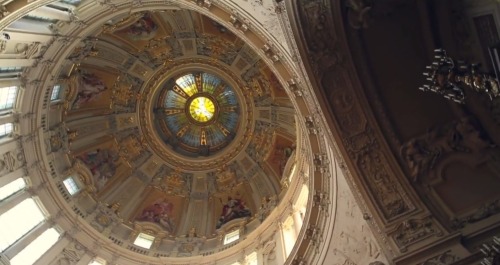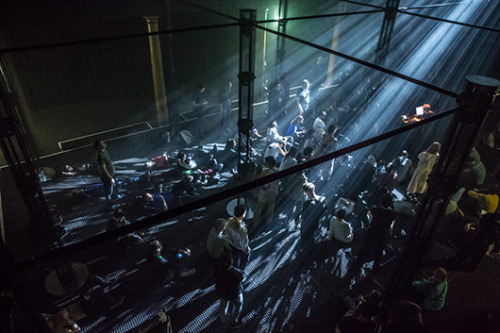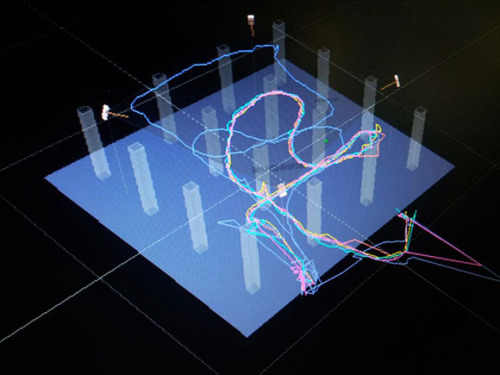Noids
 Friday, November 20, 2015 at 10:51 tagged
Friday, November 20, 2015 at 10:51 tagged  installations,
installations,  instruments,
instruments,  percussion,
percussion,  performance,
performance,  spatial
spatial Sounds of Idaho (May 16, 2025 18:56)
Introducing the Sounds of Idaho. This curated collection of thoughtfully crafted, tight...
Behind the Gritty Sound of War in ‘Lee’ – with Mike Prestwood Smith and Jimmy Boyle (May 16, 2025 15:05)
Mike Prestwood Smith and Jimmy Boyle talk about setting the scene with sounds of war, p...
308 – MPSE Presents: Finding A Film’s Sonic Voice With Johnnie Burn & Paul Davies (May 15, 2025 17:09)
While in London, Tonebenders was invited to Wave Studios in Soho, to talk to Johnnie Bu...
 Friday, November 20, 2015 at 10:51 tagged
Friday, November 20, 2015 at 10:51 tagged  installations,
installations,  instruments,
instruments,  percussion,
percussion,  performance,
performance,  spatial
spatial  Monday, May 11, 2015 at 9:45 tagged
Monday, May 11, 2015 at 9:45 tagged  festivals,
festivals,  fivesoundquestions,
fivesoundquestions,  spatial
spatial The recurring FIBER Festival, which is happening in Amsterdam on the 15th & 16th of May presents the forefront of audiovisual performances, interactive installations, artist and company showcases and cutting-edge electronic music in one unified experience. This year, the theme is “Subterranean; Exploring Networked Tools and Matter”. With this theme, the festival researches new forms of art that offer a peek into the networked, “smart” landscape which has emerged from a worldwide explosion of digital technology. With an exposition, workshops, a symposium, a club night, and several AV & Music performances, FIBER Festival will immerse the audience in all that is the Subterranean. During FIBER, sound artist Zeno van den Broek will premiere his new AV work Divergence, a synergy between sound, vision, and space.

Zeno’s work revolves around space, spatiality and time, using both the audial and the visual to influence space and spatial awareness. Trained as an architect, Zeno explores the richness and complexity through different modes of expression. His new album and performance “Divergence” explores the tension between space and sound and the sound induced by their manipulated representation. The album is based on pure sound waves such as sine waves and white noise, manipulating these with tape or physically to create a divergence between the perception of sound and space. Real and digital spaces interact with pure and altered sound sources, resulting in an intense sensory reaction and heightened spatial awareness through four movements.
We’re very curious to Zeno’s ideas about sound, and are thus very glad to be able to a Five Sound Questions interview with Zeno!
1. What sound from your childhood made the most impression on you?
One of my strongest memories of sound is the echoing of sounds between the apartment blocks where I grew up. The sound of a motorbike or the claxon of a car was never just the pure single sound but a multiplicity of claxons and motors, moving through the neighborhood which made it often impossible to link the sound to its source.
2. How do you listen to the world around you?
Because I’ve spend so much time intensely listening and analyzing the sound in relation to its surroundings such as reverberation and reflections I have a hard time shutting of this kind of active listening. I often find myself paying more attention to the sound of a space than to the actual subject such as a concert. This does give me beautiful and interesting experiences but sometimes I wish I could just simply enjoy the music.
3. Which place in the world do you favor for its sound?
I don’t have a specific place I would like to mention but often when people warn me for ‘bad’ places to perform sound in due to things like excessive or weird reverberation. I love working with these places, using their characteristics to shape my sounds and to bring their qualities into expression.
4. How could we make sound improve our lives?
If we all would be more aware of the impact the sounds we create have for our surroundings we would be able to improve our living environment. A sound is not something you can just turn away from and it will disappear, sound infiltrates our bodies and minds and can alter our being. The spatial area sound interacts with is something that is often overlooked.
5. What sound would you like to wake up to?
Silence.
Thanks Zeno! See answers by other artists in the Five Sound Questions section, and be sure to Zeno out at the FIBER Festival on the 16th of May in Amsterdam or at the Divergence release party at Vechtclub XL on the 24th of May in Utrecht!
 Tuesday, May 5, 2015 at 17:01 tagged
Tuesday, May 5, 2015 at 17:01 tagged  dance,
dance,  interdisciplinary,
interdisciplinary,  multidisciplinary,
multidisciplinary,  spatial
spatial 
Mira Calix is a composer, sound designer and audio sculptor, who originally established herself releasing music on Warp Records. Since some time, she’s been incorporating her classical orchestral music into her installation pieces an theatre and opera performances.

Her latest piece, Inside There Falls, is a multi-sensory installation consisting on paper, sound, music and movement. This way, she wants us to think about storytelling and it’s essence, no matter the medium. She’s created a shimmering white environment, both physical and sonic, for the audience to explore and to experience (as you can see in the documentation from 02:30 on). The landscape seamlessly blends technology and organic materials. Comprised of over a kilometre of colossal paper sheets, a salt covered floor, a sizeable sphere of decaying paper suspended above a giant bowl of cinnamon powder, bespoke sound composition and ethereal dancers weaving amongst the multi-layered space. The blend of materials is of the essence for Calix, as the processed paper acts as a speaker, the dance is an intervention, and the light is instrumental. The story is what matters.
I love seeing multidisciplinary pieces like this, although they might be hard to wrap your head around when you’re not physically there and can only experience it by video.
 Sunday, February 1, 2015 at 11:53 tagged
Sunday, February 1, 2015 at 11:53 tagged  composers,
composers,  composition,
composition,  spatial,
spatial,  stockhausen,
stockhausen,  xenakis
xenakis Most composers have composed their music based on the assumption that the audience will experience the works facing a stage with musicians. Most classical works aren’t made to be listened to from behind the stage. On the other hand, composers like Karlheinz Stockhausen and Iannis Xenakis have been working with the location of their audiences in mind, spatializing the music.
Young composer Chatori Shimizu (1990) wants to do this differently with -shikaku-, which is derived from the Japanese homophones “四角 (square)”, “視覚 (visual)”, and “死角 (blind spot)”, all pronounced “Shikaku”.
The setting of this work is designed so that the music is delivered to audience members surrounding the chamber orchestra, with deliberate blind spots.
All audience members have a different “blind spot”, none of them will experience the work in the same way. This reflects the story of “Blind Men and An Elephant”, where a group of blind men touch an elephant, each feeling a different part of the animal, and discussing it. Argument breaks down when the men starts to claim that an elephant was a thin, floppy, fan-like creature, as another states that it was a smooth, solid being. Not one man’s statement is untrue, as those are the precise features of an elephant.
 Tuesday, November 25, 2014 at 12:52 tagged
Tuesday, November 25, 2014 at 12:52 tagged  art,
art,  bells,
bells,  exhibition,
exhibition,  sound,
sound,  soundart,
soundart,  spatial,
spatial,  speakers
speakers Konrad Smoleński is an artist working in different fields, often collaborating with other artists and musicians. He works and lives in Warschau and Bern. His works are often big and sculptural, connected to sound or video.

His work “Everything Was Forever, Until It Was No More”, is a sculptural instrument written for two bronze bells, two walls of loudspeakers and resonating objects, in this case resonating lockers. The composition links the rich symbolic sound of the clocks to the abstract sound of reverb and resonating noise. By using delay and other effects, Smoleński creates a world wherein history comes to a standstill.
This installation is one of many which can be seen at Orkest! a group exhibition featuring works by Rutger Zuydervelt, Julian Sartorius, Oliver Beer, Rubén D’hers, Michael Schmid, and Nicolas Field. Orkest! can be seen from the 7th of december 2014 until the 6th of march 2015 at the Netwerk / centre for Contemporary art in Aalst, Belgium. We’ll feature some other works from this exhibition in the coming weeks.
Korinsky is a Berlin-based art collective using technologies and the knowledge about human hearing processes to create sound installations that play with the contrast of visual and acoustic impressions. We’ve seen them before here at EL, with their project 3845 m/s.

Their latest project is Volum. For this project, Korinsky worked together with a group of architecture students and professor Katrin Günther to explore the non-visual part of architecture. The students got to explore the way the Berliner Dom reacts to sounds, completely imprinting it’s architectonic qualities on the sounds in the dome. The absolutely amazing short documentary explains their work in the best way possible, so I won’t write too much about it.
Brilliant project. In an age where all disciplines seem to shift into each other, sound and architecture seem like two we’d really need to spend more time on. Like the narrator asks at the end of the short documentary:
“Next time you enter a building, think about it makes you feel. How does it affect you acoustically?”
 Tuesday, October 21, 2014 at 0:10 tagged
Tuesday, October 21, 2014 at 0:10 tagged  installations,
installations,  soundart,
soundart,  spatial
spatial 


